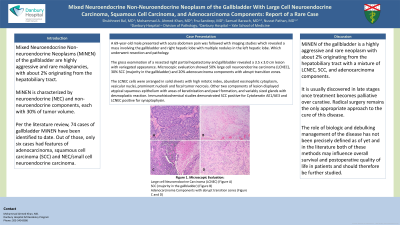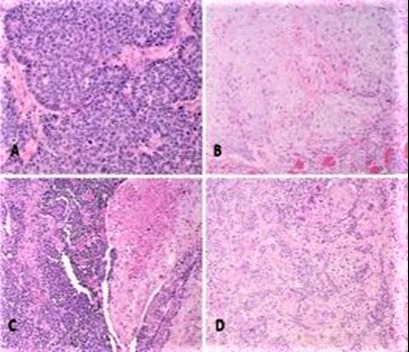Monday Poster Session
Category: Biliary/Pancreas
P1545 - Mixed Neuroendocrine Non-Neuroendocrine Neoplasm of the Gallbladder With Large Cell Neuroendocrine Carcinoma, Squamous Cell Carcinoma, and Adenocarcinoma Components: Report of a Rare Case
Monday, October 23, 2023
10:30 AM - 4:15 PM PT
Location: Exhibit Hall

.jpeg.jpg)
Mohammad A. Ahmed-Khan, MD
Danbury Hospital - Yale School of Medicine
Danbury, CT
Presenting Author(s)
Shubhneet Bal, MD1, Mohammad A. Ahmed-Khan, MD2, Fnu Sandeep, MD1, Samuel Barasch, MD1, Nusrat Pathan, MD1
1Danbury Hospital, Danbury, CT; 2Danbury Hospital - Yale School of Medicine, Danbury, CT
Introduction: Mixed neuroendocrine non-neuroendocrine neoplasms (MiNEN) of the gallbladder are highly aggressive and rare malignancies, with about 2% originating from the hepatobiliary tract. MiNEN is characterized by neuroendocrine (NEC) and non-neuroendocrine components, each with 30% of tumor volume. Per the literature review, 74 cases of gallbladder MiNEN have been identified to date. Out of those, only six cases had features of adenocarcinoma, squamous cell carcinoma (SCC) and NEC/small cell neuroendocrine carcinoma.
Case Description/Methods: We report a case of a 69-year-old man who presented with acute abdomen pain followed by imaging studies which revealed a mass involving the gallbladder and right hepatic lobe with multiple nodules in the left hepatic lobe. The gross examination of a resected right partial hepatectomy and gallbladder revealed a 3.5 x 3.0 cm lesion with variegated appearance. Microscopic evaluation showed 50% large cell neuroendocrine carcinoma (LCNEC), 30% SCC (majority in the gallbladder) and 20% adenocarcinoma components with abrupt transition zones. The LCNEC cells were arranged in solid sheets with high mitotic index, abundant eosinophilic cytoplasm, vesicular nuclei, prominent nucleoli and focal tumor necrosis. Other two components of lesion displayed atypical squamous epithelium with areas of keratinization and pearl formation, and variably sized glands with desmoplastic reaction. Immunohistochemical studies demonstrated SCC positive for Cytokeratin AE1/AE3 and LCNEC positive for synaptophysin.
Discussion: MiNEN of the gallbladder is a highly aggressive and rare neoplasm with about 2% originating from the hepatobiliary tract with a mixture of LCNEC, SCC, and adenocarcinoma components. It is usually discovered in late stages once treatment becomes palliative over curative. Radical surgery remains the only appropriate approach to the cure of this disease. The role of biologic and debulking management of the disease has not been precisely defined as of yet and in the literature both of these methods may influence overall survival and postoperative quality of life in patients and should therefore be further studied.

Disclosures:
Shubhneet Bal, MD1, Mohammad A. Ahmed-Khan, MD2, Fnu Sandeep, MD1, Samuel Barasch, MD1, Nusrat Pathan, MD1. P1545 - Mixed Neuroendocrine Non-Neuroendocrine Neoplasm of the Gallbladder With Large Cell Neuroendocrine Carcinoma, Squamous Cell Carcinoma, and Adenocarcinoma Components: Report of a Rare Case, ACG 2023 Annual Scientific Meeting Abstracts. Vancouver, BC, Canada: American College of Gastroenterology.
1Danbury Hospital, Danbury, CT; 2Danbury Hospital - Yale School of Medicine, Danbury, CT
Introduction: Mixed neuroendocrine non-neuroendocrine neoplasms (MiNEN) of the gallbladder are highly aggressive and rare malignancies, with about 2% originating from the hepatobiliary tract. MiNEN is characterized by neuroendocrine (NEC) and non-neuroendocrine components, each with 30% of tumor volume. Per the literature review, 74 cases of gallbladder MiNEN have been identified to date. Out of those, only six cases had features of adenocarcinoma, squamous cell carcinoma (SCC) and NEC/small cell neuroendocrine carcinoma.
Case Description/Methods: We report a case of a 69-year-old man who presented with acute abdomen pain followed by imaging studies which revealed a mass involving the gallbladder and right hepatic lobe with multiple nodules in the left hepatic lobe. The gross examination of a resected right partial hepatectomy and gallbladder revealed a 3.5 x 3.0 cm lesion with variegated appearance. Microscopic evaluation showed 50% large cell neuroendocrine carcinoma (LCNEC), 30% SCC (majority in the gallbladder) and 20% adenocarcinoma components with abrupt transition zones. The LCNEC cells were arranged in solid sheets with high mitotic index, abundant eosinophilic cytoplasm, vesicular nuclei, prominent nucleoli and focal tumor necrosis. Other two components of lesion displayed atypical squamous epithelium with areas of keratinization and pearl formation, and variably sized glands with desmoplastic reaction. Immunohistochemical studies demonstrated SCC positive for Cytokeratin AE1/AE3 and LCNEC positive for synaptophysin.
Discussion: MiNEN of the gallbladder is a highly aggressive and rare neoplasm with about 2% originating from the hepatobiliary tract with a mixture of LCNEC, SCC, and adenocarcinoma components. It is usually discovered in late stages once treatment becomes palliative over curative. Radical surgery remains the only appropriate approach to the cure of this disease. The role of biologic and debulking management of the disease has not been precisely defined as of yet and in the literature both of these methods may influence overall survival and postoperative quality of life in patients and should therefore be further studied.

Figure: Microscopic Evaluation:
Large cell Neuroendocrine Carcinoma (LCNEC) (Figure A)
SCC (majority in the gallbladder) (Figure B)
Adenocarcinoma Components with abrupt transition zones (Figure C and D)
Large cell Neuroendocrine Carcinoma (LCNEC) (Figure A)
SCC (majority in the gallbladder) (Figure B)
Adenocarcinoma Components with abrupt transition zones (Figure C and D)
Disclosures:
Shubhneet Bal indicated no relevant financial relationships.
Mohammad Ahmed-Khan indicated no relevant financial relationships.
Fnu Sandeep indicated no relevant financial relationships.
Samuel Barasch indicated no relevant financial relationships.
Nusrat Pathan indicated no relevant financial relationships.
Shubhneet Bal, MD1, Mohammad A. Ahmed-Khan, MD2, Fnu Sandeep, MD1, Samuel Barasch, MD1, Nusrat Pathan, MD1. P1545 - Mixed Neuroendocrine Non-Neuroendocrine Neoplasm of the Gallbladder With Large Cell Neuroendocrine Carcinoma, Squamous Cell Carcinoma, and Adenocarcinoma Components: Report of a Rare Case, ACG 2023 Annual Scientific Meeting Abstracts. Vancouver, BC, Canada: American College of Gastroenterology.
